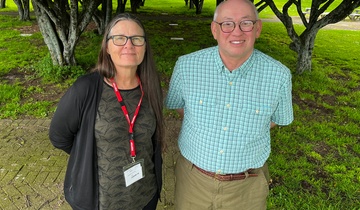That sinking feeling
Evaluations of coastal wetland resilience to rising sea levels must be based on site measurements rather than relying on sea-level trends from off-site tide gauges.
Mangrove forests are a major component of coastal wetlands in the tropics of the Indo-Pacific Region, occupying tens of thousands of square kilometres of muddy coast and river deltas. Mangrove forests also occur in the temperate estuaries of New Zealand’s upper North Island, where they have rapidly expanded their distribution over the last 50 years due to increased soil erosion and resulting estuary sedimentation.
Mangrove forests provide a range of ecosystem services, functioning as long-term sinks for stormwater contaminants and sequestering carbon, supporting biodiversity and coastal food-webs and providing nurseries for some estuarine and coastal fisheries. They can also reduce the impact of coastal erosion and inundation hazards associated with local wind and swell waves, storm tides and tsunami.
In New Zealand, opinions about mangroves have become polarised over the last decade, with environmental groups advocating protection at all costs whereas a number of community and harbour care groups have lobbied local government agencies for mangrove removal. In sharp contrast, large-scale mangrove forest restoration projects are underway in South-East Asia to offset the impacts of rapidly subsiding coasts starved of sediments by dam construction and rising sea levels due to climate warming.
Research conducted by NIWA in the southern Firth of Thames over the last several years, in collaboration with scientists from New Zealand, Australia, USA and the Netherlands, is shedding new light on the old concept of mangroves as “land builders”, the role that mangroves play in estuary sedimentation and their resilience to rising sea levels (Figure 1). Work recently published has demonstrated for the first time that mangrove forests colonising tidal flats in “sediment-rich” environments, such as our estuaries, do not increase sedimentation rates. Mangrove-seedling recruitment is also strongly influenced by sea-level variations during the spring–neap tidal cycle and seabed disturbance by waves.
Ultimately, the fate of mangrove forests depends on the elevation of the mangrove tidal flat keeping pace with relative sea-level rise (RSLR). The RSLR (i.e., local) trend at a given location is determined by the combined effects of increasing sea level due to global and NZ-wide climate change, vertical land motion due to tectonic processes, and compaction of sediments. The rate of RSLR on subsiding coasts can be substantially higher than on stable coasts.
In the southern Firth, deep-set Rod Surface Elevation Table (RSET) benchmarks were installed in 2007. Subsequent surveys demonstrate that the mangrove forest is subsiding at 7.7 to 9.4 (±0.5) mm per year (mm/yr), mainly due to compaction of sediments (Figures 2 and 3). These subsidence rates are similar to values of 7–8.4 mm/year since the late 1960s inferred from dated sediment cores and two- to three-fold higher than values recorded at the nearby Tararu tide gauge (3.6 ± 0.7 mm/yr, Thames), indicating that sediment compaction is the major driver of the long-term relative sea-level trend in the mangrove forest.
Our findings suggest that: (1) regional tide gauge records may not provide transferable estimates of RSLR for coastal wetlands due to local subsidence associated with natural processes and human activities; (2) subsidence rates and relative sea-level rise within coastal wetlands can be evaluated using campaign-GPS surveys of RSET benchmarks and independently from longer-term sedimentary records; (3) Relative sea-level rise in the southern Firth at close to 10 mm/yr is within the range of SLR estimates for most of the New Zealand coast expected by the end of this century due to climate warming. The fact that the Firth mangrove forest has so far kept pace with rapid RSLR highlights the importance of sediment supply to sustain the response to RSLR. Finally, evaluations of the resilience of coastal wetlands to rising sea level over the coming decades must be based on measurements of RSLR from these systems themselves and compared with regional tide gauges.


Further information:
Swales, A., Denys, P., Pickett, V.I., Lovelock, C.E., 2016: Evaluating deep subsidence in a rapidly-accreting mangrove forest using GPS monitoring of surface-elevation benchmarks and sedimentary records. Marine Geology dx.doi.org/10.1016/j.margeo.2016.04.015
Lovelock, C.E., Cahoon, D.R., Friess, D.A., Guntenspergen, G.R., Krauss, K.W., Reef, R., Rogers, K., Saunders, M., Sidik, F., Swales, A., Saintilan, N., Thuyen, L.X., Triet, T., 2015: The vulnerability of Indo-Pacific mangrove forests to sea level rise. Nature 526: 559–563, doi: 10.1038/nature15538.
Swales, A., Bentley, S.J., Lovelock, C.E., 2015: Mangrove-forest evolution in a sediment-rich estuarine system: Opportunists or agents of geomorphic change? Earth Surface Processes and Landforms 40: 1672–1687, doi: 10.1002/esp.3759.
Balke, T., Swales, A., Lovelock, C.E., Herman, P. M. J., Bouma, T.J., 2015: Limits to seaward expansion of mangroves: Translating physical disturbance mechanisms into seedling survival gradients. Journal of Experimental Marine Biology and Ecology 467: 16–25.
Morrisey D.J., Swales A., Dittmann S., Morrison M.A., Lovelock C.E., Beard C.M. 2010. The Ecology and Management of Temperate Mangroves. Oceanography and Marine Ecology: An Annual Review 48: 43–160.







